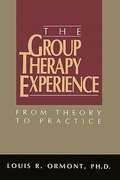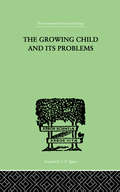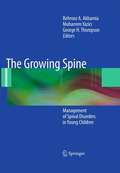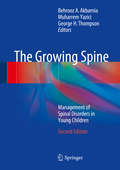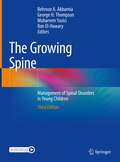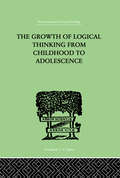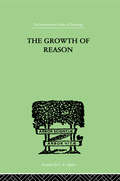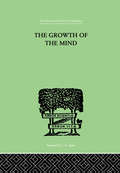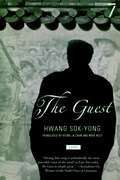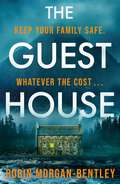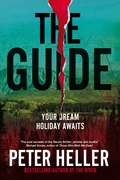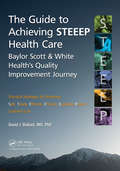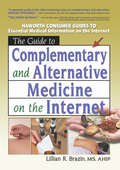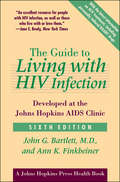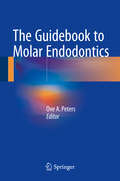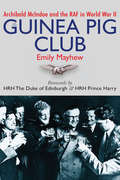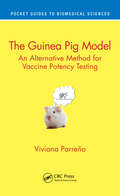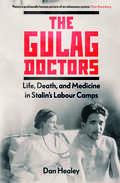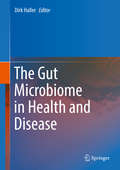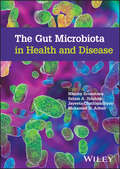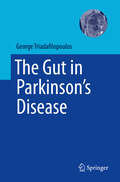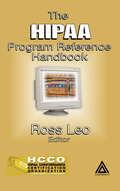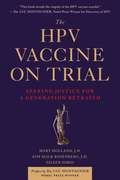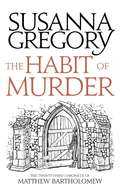- Table View
- List View
The Group Therapy Experience From Theory To Practice
by Louis OrmontIn this definitive work, internationally renowned group therapist Dr. Louis Ormont sets down the techniques and innovations that give the group experience its unique therapeutic power. From Theory to Practice, Dr. Ormont discusses techniques such as those of identifying people's problems, dealing with resistances, helping members confirm new identities, and termination itself.
The Growing Child And Its Problems (International Library Of Psychology Ser. #Vol. 79)
by Miller, EmanuelFirst Published in 1999. Routledge is an imprint of Taylor & Francis, an informa company.
The Growing Spine
by Muharrem Yazici George H. Thompson Behrooz A. AkbarniaSpinal disorders in very young children may be caused by a variety of conditions. The treatment of such conditions is often challenging due to the age of the patient and the progressive nature of the deformity. There also may be associated problems such as congenital anomalies, respiratory insufficiency, and neurological problems. Depending on the etiology of the deformity, these children are often cared for by multiple specialists including pediatricians, pediatric orthopaedists or orthopaedic spine surgeons, neurologists, pediatric surgeons, pediatric neurosurgeons, oncologists, and/or pulmonologists. Health professionals in all of the mentioned disciplines are involved in the management of these patients, which is why compiling a comprehensive textbook that is not limited to orthopedic specialists is essential. This textbook will effectively help to standardize the care of these patients. Furthermore, other professionals such as nurses, physical therapists and healthcare professionals in training are usually not familiar with these conditions and are in need of a reference book to consult when caring for children with spinal deformities.
The Growing Spine, 2nd Edition
by Muharrem Yazici George H. Thompson Behrooz A. AkbarniaThe second edition of The Growing Spine has been extensively revised to cover recent advances in knowledge and management. The book is intended as a comprehensive, one-stop reference for specialists and health professionals who care for young children with spinal deformities. In addition, it will effectively help to standardize the care of these patients. Depending on the etiology, children with spinal deformities are often cared for by multiple specialists, including pediatricians, pediatric orthopaedists or orthopaedic spine surgeons, neurologists, pediatric surgeons, pediatric neurosurgeons, oncologists, and pulmonologists. The multidisciplinary nature of care is reflected in The Growing Spine, which will be of value for all involved practitioners rather than just orthopaedic specialists. It will also be an ideal reference for nurses, physical therapists, and healthcare professionals in training, who are usually unfamiliar with spinal deformities in children.
The Growing Spine: Management of Spinal Disorders in Young Children
by Muharrem Yazici George H. Thompson Behrooz A. Akbarnia Ron El-HawaryThere has been significant progress in the field of spinal disorders in very young children over the past two decades. However, the treatment of such conditions remains challenging due to the age of the patient, different etiologies, associated morbidities and the progressive nature of the deformity. Depending on the etiology of the deformity, these children are often cared for by multiple specialists including pediatricians, pulmonologists, pediatric orthopedists or orthopedic spine surgeons, pediatric surgeons, pediatric neurosurgeons, neurologists and oncologists. Health professionals in all of the mentioned disciplines are involved in the management of these patients, which is why compiling a comprehensive text that is not limited to orthopedic specialists is essential. Since the second edition of this book was published, there has been a significant body of literature that has been published and advances made in the care of young children with spinal and thoracic deformities. This new edition will effectively help to standardize the care of these patients. Furthermore, other professionals, such as nurses, physical therapists and healthcare professionals in training, are usually not familiar with these conditions and are in need of a reference book to consult when caring for young children with spinal deformities. Sections are arranged thematically and comprise a comprehensive presentation of the current knowledge on disorders of the growing spine. After opening sections discussing general considerations and patient evaluation and diagnosis, subsequent sections describe the various categories of spinal deformity - idiopathic, congenital, neuromuscular, syndromic, and others - followed by surgical and non-surgical management strategies, both traditional and growth-friendly. Concluding sections address patient care and outcomes and outline future directions for research and practice.
The Growth Of Logical Thinking From Childhood To Adolescence: AN ESSAY ON THE CONSTRUCTION OF FORMAL OPERATIONAL STRUCTURES (International Library Of Psychology Ser.)
by Piaget, Jean & Inhelder, BrbelThis is Volume XXII of thirty-two on a series of Developmental Psychology. Originally published in 1958, this text offers a translation from French of an essay on the construction of formal operational structures to explain part of the growth of logic in a child's brain and development. It looks at propositional logic, the integration of formal thought and the operational schemata of formal logic.
The Growth Of Reason: A STUDY OF the Role of Verbal Activity in the Growth of the (International Library Of Psychology Ser.)
by Lorimer, FrankFirst Published in 1999. Routledge is an imprint of Taylor & Francis, an informa company.
The Growth of the Mind: An Introduction to Child-Psychology (International Library Of Psychology Ser.)
by K. KoffkaFirst Published in 1999. Routledge is an imprint of Taylor & Francis, an informa company.
The Guest
by Hwang Sok-YongBased on actual events, The Guest is a profound portrait of a divided people haunted by a painful past, and a generation's search for reconciliation. During the Korean War, Hwanghae Province in North Korea was the setting of a gruesome fifty-two day massacre. In an act of collective amnesia the atrocities were attributed to American military, but in truth they resulted from malicious battling between Christian and Communist Koreans. Forty years later, Ryu Yosop, a minister living in America returns to his home village, where his older brother once played a notorious role in the bloodshed. Besieged by vivid memories and visited by the troubled spirits of the deceased, Yosop must face the survivors of the tragedy and lay his brother's soul to rest. Faulkner-like in its intense interweaving narratives, The Guest is a daring and ambitious novel from a major figure in world literature.
The Guest House
by Robin Morgan-BentleyKEEP YOUR FAMILY SAFE.WHATEVER THE COST...Jamie and Victoria are expecting their first baby.With a few weeks to go, they head off for a final weekend break in a remote part of the North Pennines. The small and peaceful guesthouse is the ideal location to unwind together before becoming parents. Upon arrival, they are greeted by Barry and Fiona, the older couple who run the guesthouse. They cook them dinner and show them to their room before retreating to bed themselves.The next morning, Jamie and Victoria wake to find the house deserted. Barry and Fiona are nowhere to be seen. All the doors are locked. Both their mobile phones and car keys have disappeared. Even though it's a few weeks early, Victoria knows the contractions are starting.The baby is coming, and there's no way out.
The Guest House: ‘A tense spin on the locked-room mystery’ Observer
by Robin Morgan-Bentley'Atmospheric, original and tension-filled, THE GUEST HOUSE will keep you on the edge of your seat.' T.M. Logan, author of THE CURFEWKEEP YOUR FAMILY SAFE.WHATEVER THE COST...Jamie and Victoria are expecting their first baby.With a few weeks to go, they head off for a final weekend break in a remote part of the North Pennines. The small and peaceful guesthouse is the ideal location to unwind together before becoming parents. Upon arrival, they are greeted by Barry and Fiona, the older couple who run the guesthouse. They cook them dinner and show them to their room before retreating to bed themselves.The next morning, Jamie and Victoria wake to find the house deserted. Barry and Fiona are nowhere to be seen. All the doors are locked. Both their mobile phones and car keys have disappeared. Even though it's a few weeks early, Victoria knows the contractions are starting.The baby is coming, and there's no way out.
The Guide
by Peter Heller'The poet laureate of the literary thriller: sinister and soulful'Michael Koryta, author of Those Who Wish Me DeadThe best-selling author of The River returns with a heart-racing thriller about a young man escaping his own grief and an elite fishing lodge in Colorado hiding a plot of shocking menace Kingfisher Lodge: a boutique resort surrounded by a mile and a half of the most pristine river water on the planet.Safe from viruses that have plagued America for years, Kingfisher offers a respite for wealthy clients - and a return to normality for fishing guide Jack, battling the demons of a recent, devastating loss. But when a human scream pierces the night, Jack soon realises that the idyllic retreat may be merely a cover for a far more sinister operation.Lucy Foley meets Liane Moriarty's Nine Perfect Strangers, with the lyrical writing of Robert Macfarlane and an eerily plausible twist... PRAISE FOR PETER HELLER AND THE RIVER'Glorious prose and razor-sharp tension' Observer Thrillers of the Year'Utter joy... A suspenseful tale told with glorious drama and lyrical flair'Denise Mina, New York Times'Urgent, visceral writing - I couldn't turn the pages fast enough'Clare Mackintosh 'Lyrical and action-packed by turns' Guardian 'A master of suspense... A thrilling read with a dramatic twist at the end: you will not be able to put it down' The Lady'A must read' Daily Express'Heller packs a ton of adventure and emotion in this short novel, and I dare you to put it down once you've picked it up' Criminal Element
The Guide to Achieving STEEEP™ Health Care: Baylor Scott & White Health's Quality Improvement Journey
by David J. Ballard MD PhD.Achieving health care that is safe, timely, effective, efficient, equitable, and patient-centered (STEEEP) is not an endpoint, but a journey. This journey requires a commitment to quality improvement (QI) from the highest levels of leadership combined with the interdependent development of several key components of health care delivery: administrat
The Guide to Complementary and Alternative Medicine on the Internet
by M Sandra Wood Lillian R BrazinLearn to identify Internet-based complementary/alternative medicine resources you can trust! This well-organized book takes a commonsense approach to getting the most out of the Internet when it comes to finding reliable information on complementary and alternative medicine. Author Lillian Brazin teaches classes on finding and evaluating health information on the Internet. In this book, she shares her years of experience in using and evaluating medical Internet sites to teach you to spot authoritative resources and avoid misinformation, sales pitches, and out-and-out quackery. In addition to showing you where to find the information you need, this book stresses the importance (the how and why) of working closely with your physician to get the best results from your complementary/alternative medical experience. More than 20 "screen shot" illustrations give you a preview of what to look for on various sites! The Guide to Complementary and Alternative Medicine on the Internet will show you how to separate the wheat from the chaff when confronted with hundreds of Web sites purporting to provide reliable information. This jargon-free book addresses vital questions, such as: How can I be certain that the information I find is correct? How can I locate a Web site that was recommended to me? How do I start out to research a particular health problem? What do Internet terms like .com, .edu, .gov, listservs, :), BTW, LOL, flames, "netiquette," etc. mean? This book will also help you understand controversial "hot topics" that include: the Pilates exercise method that Jacqueline Kennedy Onassis helped popularize in the 1960s is trendy again, with Pilates studios in most major cities supermarket supplements, such as St. John's wort, gingko biloba, and vitamins A-Z: how can I find out which, if any of them, are for me? the validity of celebrity endorsements for supplements and alternative therapies While providing you with the skills to find the information you seek, this book reflects the author&’s cautious perspective. The Internet can be frightening and overwhelming because there is so much information to sift through, digest, and evaluate. The Guide to Complementary and Alternative Medicine on the Internet (first in the new Internet Guides to Consumer Health Care series from The Haworth Information Press) will help you identify Internet resources for complementary and alternative medicine that you can trust.
The Guide to Living with HIV Infection: Developed at the Johns Hopkins AIDS Clinic (A Johns Hopkins Press Health Book)
by Ann K. Finkbeiner John G. BartlettThe Guide to Living with HIV Infection is the most complete source of medical, emotional, social, and practical advice available for those infected with HIV and their loved ones. Developed at the Johns Hopkins AIDS Clinic, the guide provides essential information for making decisions about treatment and testing in a world transformed by new research and pharmacotherapy.In this thoroughly updated sixth edition, Dr. John Bartlett and Ann K. Finkbeiner address the latest information about risks of transmission, viral mutations that confer drug resistance, and new, rapid, HIV testing. They offer guidelines for Highly Active Antiretroviral Therapy (HAART), a therapy protocol that has dramatically increased life expectancy for HIV-positive people. They describe how to follow HAART and when to change drug regimens, the symptoms of and treatments for HAART side effects, and the costs of and insurance coverage for HAART. They also outline the possibilities for a diagnosis of "no detectable virus."Accompanied by updated references and resources, the sixth edition of The Guide to Living with HIV Infection offers new hope for people living with a virus that once left no hope at all.
The Guidebook to Molar Endodontics
by Ove A. PetersThis volume offers readers a pragmatic approach to endodontic therapy for permanent molars, based on up-to-date evidence. All chapters were written by experts in the field, and focus on preparation for treatment, vital pulp therapy, access cavity preparation, root canal shaping, outcome assessment, retreatment, apical surgery, and specific aspects of restorations for root canal-treated molars. The role of micro-CT data in visualizing canal anatomy is compared to cone beam CT, and detailed information on current clinical tools, such as irrigation adjuncts and engine-driven preparation tools is provided. Important steps are illustrated in clinical photographs and radiographs, as well as by schematic diagrams. Tables and check boxes highlight key points for special attention, and clinical pitfalls. Guiding references are provided. Performing molar endodontics is often a daunting prospect, regardless of the practice setting. This is where "Molar Endodontics" is an ideal source of guidance for practitioners. Special devices and recent innovations in apex locators and nickel-titanium instruments have, however, made procedures significantly easier and more practical for non-specialists. This book will help conscientious clinicians to master molar endodontics with well-described and established clinical methods.
The Guinea Pig Club: Archibald McIndoe and the RAF in World War II
by Emily Mayhew HRH The Duke of Edinburgh HRH Prince Harry Duke of SussexA truly inspiring tale about the history of the Guinea Pig Club. <P><P> Plastic surgery was in its infancy before the Second World War — the most rudimentary techniques were known only to a few surgeons worldwide. The Allies were tremendously fortunate in having the maverick surgeon Archibald McIndoe operating at a small hospital in East Grinstead in the south of England. <P><P>After arguing with his superiors, McIndoe set up a revolutionary new treatment regime and rightly secured his group of patients, dubbed the Guinea Pig Club, and honoured place in society. <P><P>Based on extensive research into official records and moving first-person recollections, this extraordinary book brings home the heroism and triumphs of this courageous band of men and contains updated material on how their example is inspiring today’s wounded veterans.
The Guinea Pig Model: An Alternative Method for Vaccine Potency Testing (Pocket Guides to Biomedical Sciences)
by Viviana ParreñoThis book summarizes the development and statistical validation of a guinea pig model as an alternative for potency testing of the viral antigens included in combined vaccines applied in cattle to control the respiratory, reproductive, and neonatal calf diarrhea syndromes. The model allows, in one serum sample, to test the vaccine quality for all the viral antigens included in aqueous as well as in oil-adjuvanted formulations of bovine vaccines. The methodology proposed for the control of bovine herpes virus, parainfluenza, and rotavirus were recommended by CAMEVET as guidelines for the 30 countries in the forum, including the US.Key Features Reviews combined vaccines used for cattle Summarizes animal models used for vaccine testing Focuses on bovine herpesviruses, rotaviruses, parainfluenza, and bovine viral diarrhea virus Provides guidance on the effectiveness of the Guinea Pig model for testing vaccine immunogenicity
The Gulag Doctors: Life, Death, and Medicine in Stalin's Labour Camps
by Dan HealeyA pioneering history of medical care in Stalin&’s Gulag—showing how doctors and nurses cared for inmates in appalling conditions A byword for injustice, suffering, and mass mortality, the Gulag exploited prisoners, compelling them to work harder for better rations in shocking conditions. From 1930 to 1953, eighteen million people passed through this penal-industrial empire. Many inmates, not reaching their quotas, succumbed to exhaustion, emaciation, and illness. It seems paradoxical that any medical care was available in the camps. But it was in fact ubiquitous. By 1939 the Gulag Sanitary Department employed 10,000 doctors, nurses and paramedics—about 40 percent of whom were prisoners. Dan Healey explores the lives of the medical staff who treated inmates in the Gulag. Doctors and nurses faced extremes of repression, supply shortages, and isolation. Yet they still created hospitals, re-fed prisoners, treated diseases, and &“saved&” a proportion of their patients. They taught apprentices and conducted research too. This groundbreaking account offers an unprecedented view of Stalin&’s forced-labour camps as experienced by its medical staff.
The Gut Microbiome in Health and Disease
by Dirk HallerThe book provides an overview on how the gut microbiome contributes to human health. The readers will get profound knowledge on the connection between intestinal microbiota and immune defense systems. The tools of choice to study the ecology of these highly-specialized microorganism communities such as high-throughput sequencing and metagenomic mining will be presented. In addition the most common diseases associated to the composition of the gut flora are discussed in detail. The book will address researchers, clinicians and advanced students working in biomedicine, microbiology and immunology.
The Gut Microbiota in Health and Disease
by Jayeeta Chattopadhyay Salam A. Ibrahim Nimmy Srivastava Mohamed H. ArbabThe Gut Microbiota in Health and Disease An accessible overview of the varied microorganisms of the gut The human gut contains an extraordinary array of microorganisms existing in intricate symbiosis with the body. The gut microbiota plays a crucial role in maintaining overall gut health and warding off disease. With up to 15% of the global population suffering from Irritable Bowel Syndrome (IBS) caused by improper composition of gut microbiota, understanding these organisms and their vital contribution to human health has never been more important. The Gut Microbiota in Health and Disease provides a concise, accessible introduction to gut microbiota and their contribution to human health. It offers not only an overview of the relevant microorganisms and their roles in the body, but also extended discussion of diseases caused by gut dysbiosis. It presents a crucial window into this growing body of research into a critical area of overall human health. The Gut Microbiota in Health and Disease, readers will also find: Detailed analysis of dysbiotic health conditions including obesity, diabetes, and more Thorough treatment of molecular techniques for the analysis gut microbial composition Discussion of the lowering diversity of bacteria in the gut and the corresponding impact on global health The Gut Microbiota in Health and Disease is essential for researchers and clinicians working in immunology, gastroenterology, clinical microbiology, and related fields, as well as for clinical dieticians and postgraduate or medical students studying in these areas.
The Gut in Parkinson's Disease
by George TriadafilopoulosAt present, there is minimal and misleading knowledge of gastrointestinal dysfunction in Parkinson's disease among primary neurologists and gastroenterologists. This book reviews our current understanding of the GI involvement in PD, as many experiments suggest that the gut might be the site where the disease starts. Also discussed is how the gut dysfunction causes symptoms from the top (mouth) to the bottom (anal canal), and because of their frequency and severity, they contribute to disease progression and disability. In addition, the book covers the negative effects of small intestinal bacterial overgrowth (SIBO) and of a frequently silent stomach infection by Helicobacter pylori infection on the absorption of antiparkinsonian drugs, in turn causing motor fluctuations and inadequate treatment response. The Gut in Parkinson's Disease serves as a bridge between patients, their movement disorders specialists, and other health care providers who currently provide compartmentalized and at times conflicting care for such needy patients. The book distills the clinical and research experience of the author, who -as a Clinical Professor of Medicine (Gastroenterology) at Stanford University School of Medicine over the past 20 years- managed hundreds of patients with Parkinson’s Disease suffering from gut manifestations.
The HIPAA Program Reference Handbook
by Ross A. LeoManagement and IT professionals in the healthcare arena face the fear of the unknown: they fear that their massive efforts to comply with HIPAA requirements may not be enough, because they still do not know how compliance will be tested and measured. No one has been able to clearly explain to them the ramifications of HIPAA. Until now.The H
The HPV Vaccine On Trial: Weighing the Evidence
by Mary Holland Kim Mack Rosenberg Eileen IorioA Groundbreaking Guide to the HPV Vaccine and the Science, Safety, and Business Behind It Cancer strikes fear in people’s hearts around globe. So the appearance of a vaccine to prevent cancer–as we are assured the human papillomavirus (HPV) vaccine will–seemed like a game-changer. Since 2006, over eighty countries have approved the vaccine, with glowing endorsements from the world’s foremost medical authorities. Bringing in over $2.5 billion in annual sales, the HPV vaccine is a pharmaceutical juggernaut. Yet scandal now engulfs it worldwide. The HPV Vaccine on Trial is a shocking tale, chronicling the global efforts to sell and compel this alleged miracle. The book opens with the vaccine’s invention, winds through its regulatory labyrinths, details the crushing denial and dismissal of reported harms and deaths, and uncovers the enormous profits pharma and inventors have reaped. Authors Holland, Mack Rosenberg, and Iorio drill down into the clinical trial data, government approvals, advertising, and personal accounts of egregious injuries that have followed in countries as far-flung as Japan, Australia, Colombia, India, Ireland, the U.K. and Denmark. The authors have written an unprecedented exposé about this vaunted vaccine. Written in plain language, the book is for everyone concerned – parents, patients, doctors, nurses, scientists, healthcare organizations, government officials, and schools. Ultimately, this book is not just about the HPV vaccine, but about how industry, government, and medical authorities may be putting the world’s children in harm’s way.
The Habit of Murder: The Twenty Third Chronicle of Matthew Bartholomew (Chronicles of Matthew Bartholomew #23)
by Susanna GregoryFor the twentieth anniversary of the start of the Matthew Bartholomew series, Sphere is delighted to reissue all of the medieval monk's cases with beautiful new series-style covers.------------------------------------The twenty third chronicle of Matthew Bartholomew. In 1360 a deputation from Cambridge ventures to the Suffolk town of Clare in the hope that the wealthy Elizabeth de Burgh has left a legacy to Michaelhouse. Yet when they arrive they discover that the report of her death is false and that the college seems destined for bankruptcy.Determined to see if some of its well-heeled citizens can be persuaded to sponsor Michaelhouse, Matthew Bartholomew, Brother Michael and Master Langelee become enmeshed in the town's politics. They quickly discover that a great many other people in Clare have recently met untimely deaths. These killings, combined with the arrogance Lady de Burgh has shown over the refurbishment of the church and the grotesque behaviour of some of her entourage, have created a dangerous restlessness in the town: an atmosphere intensified when yet more murders occur.One of the victims is a fellow traveller of the Michaelhouse contingent, and Matthew Bartholomew and Brother Michael feel honour-bound to identify his killer. It is a hunt which takes them deep into Clare's murky foundations and which threatens their own survival as well as that of their beloved college.'A first-rate treat for mystery lovers' (Historical Novels Review)'Susanna Gregory has an extraordinary ability to conjure up a strong sense of time and place' (Choice)
